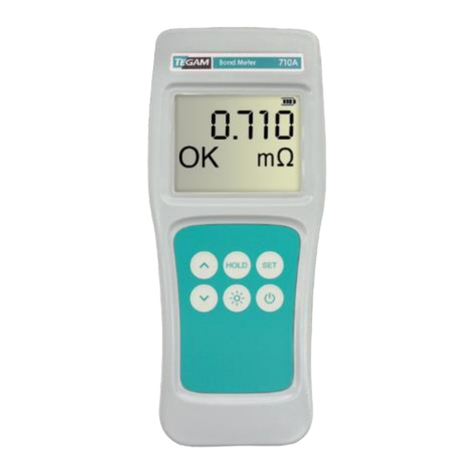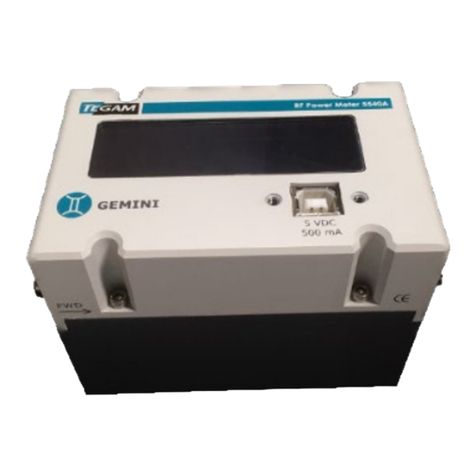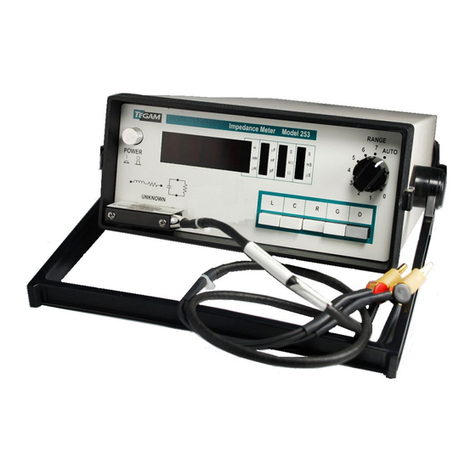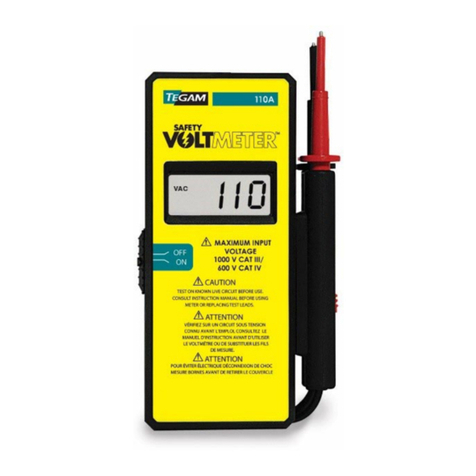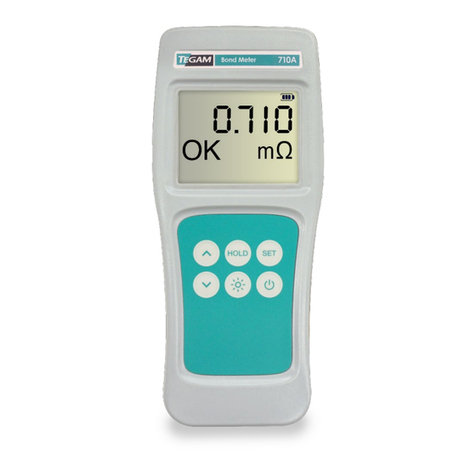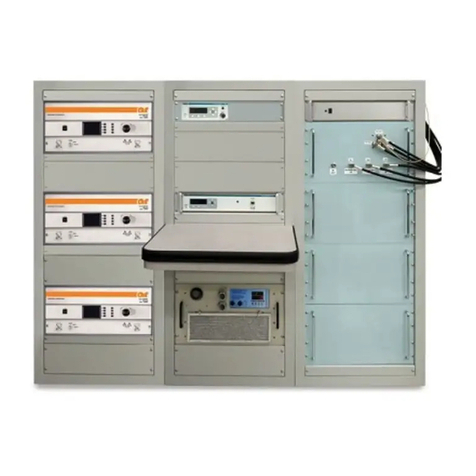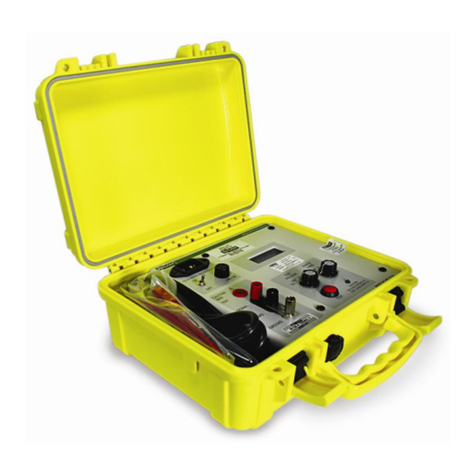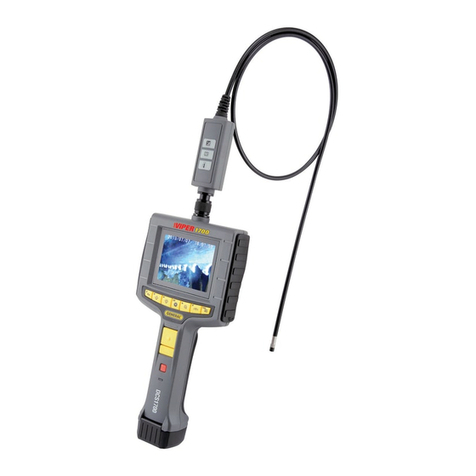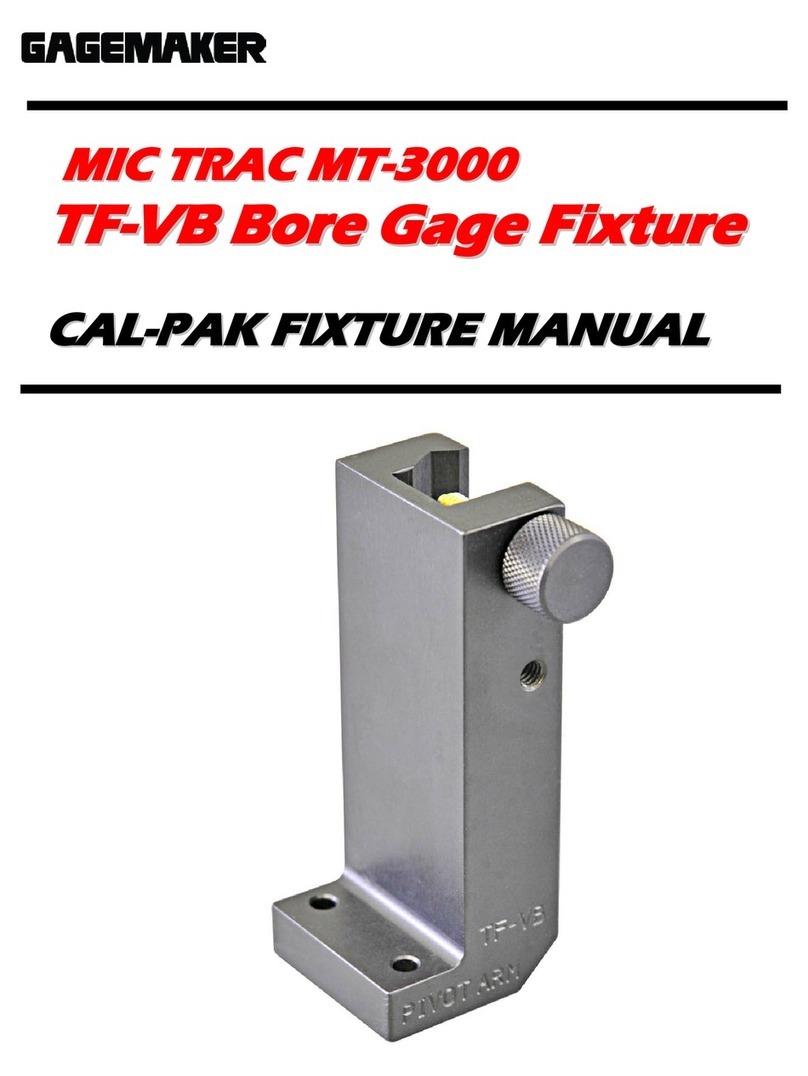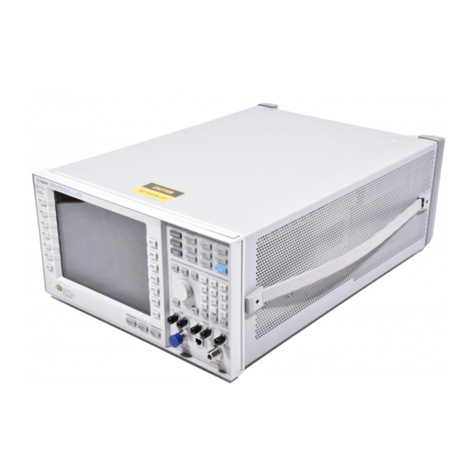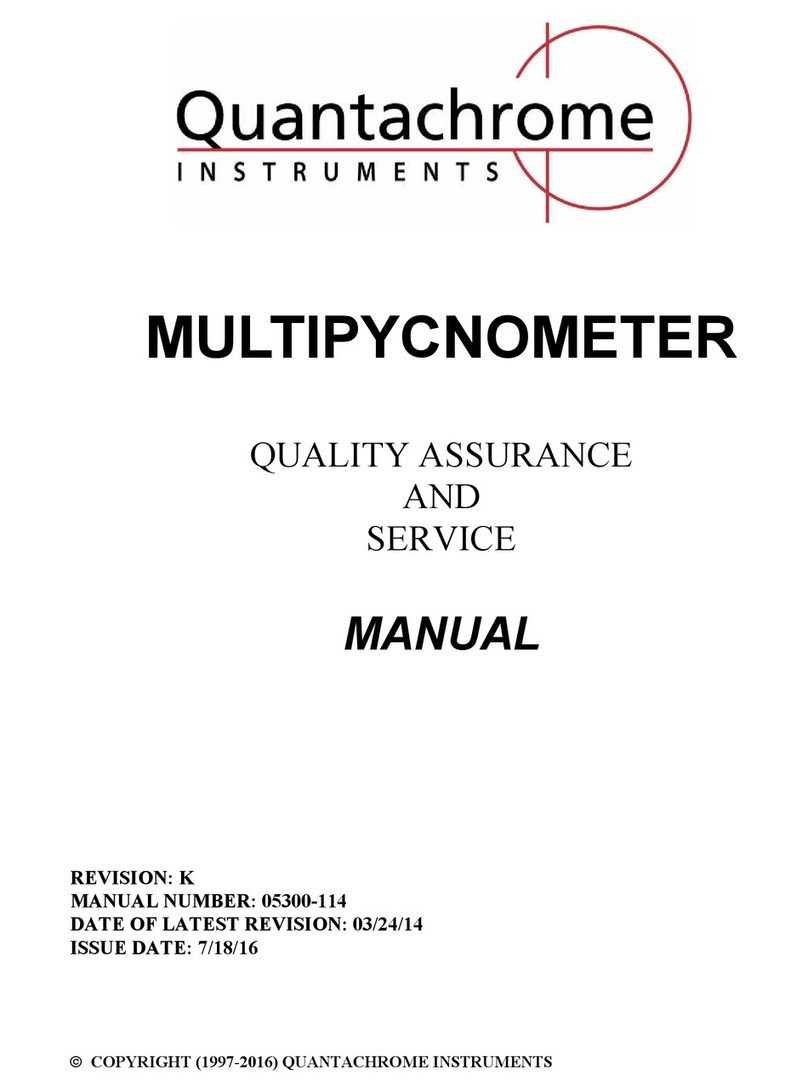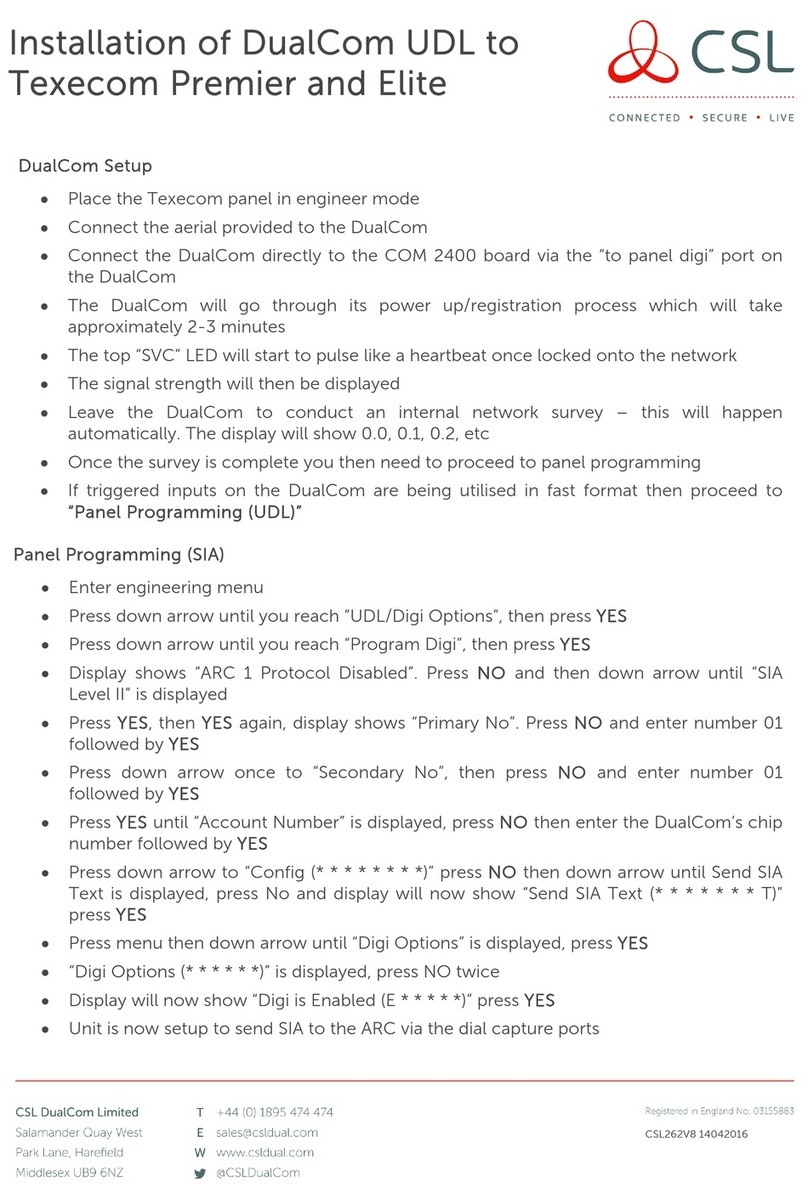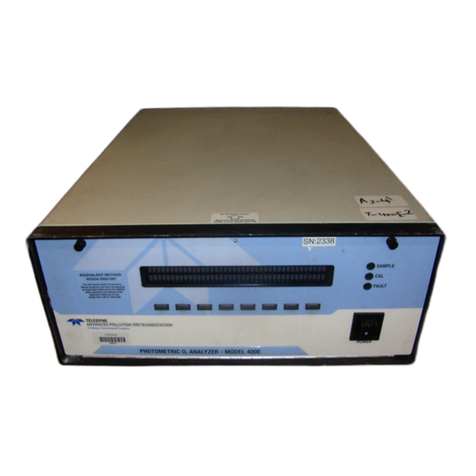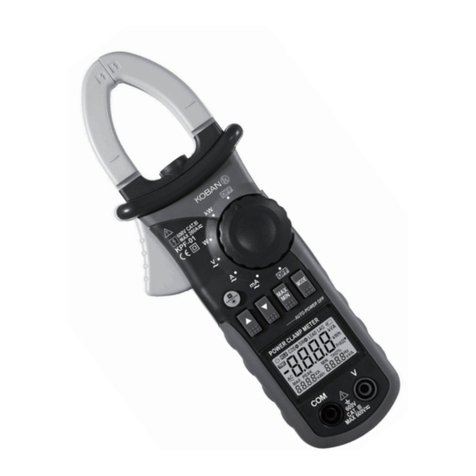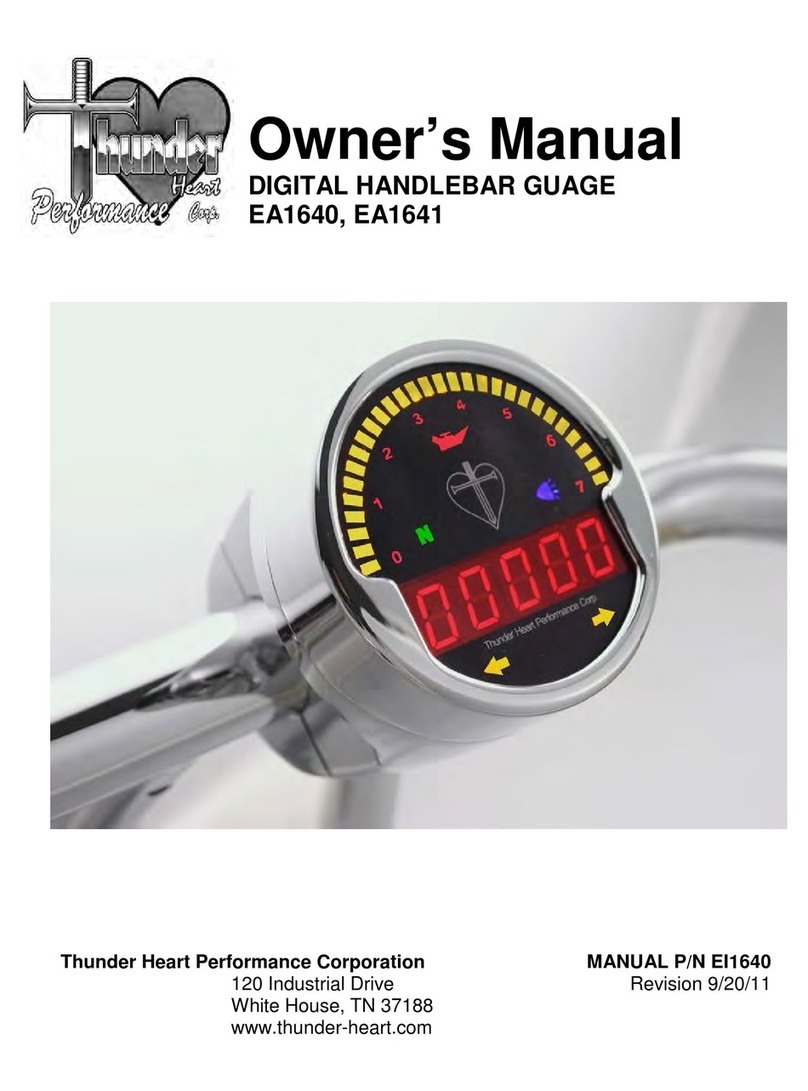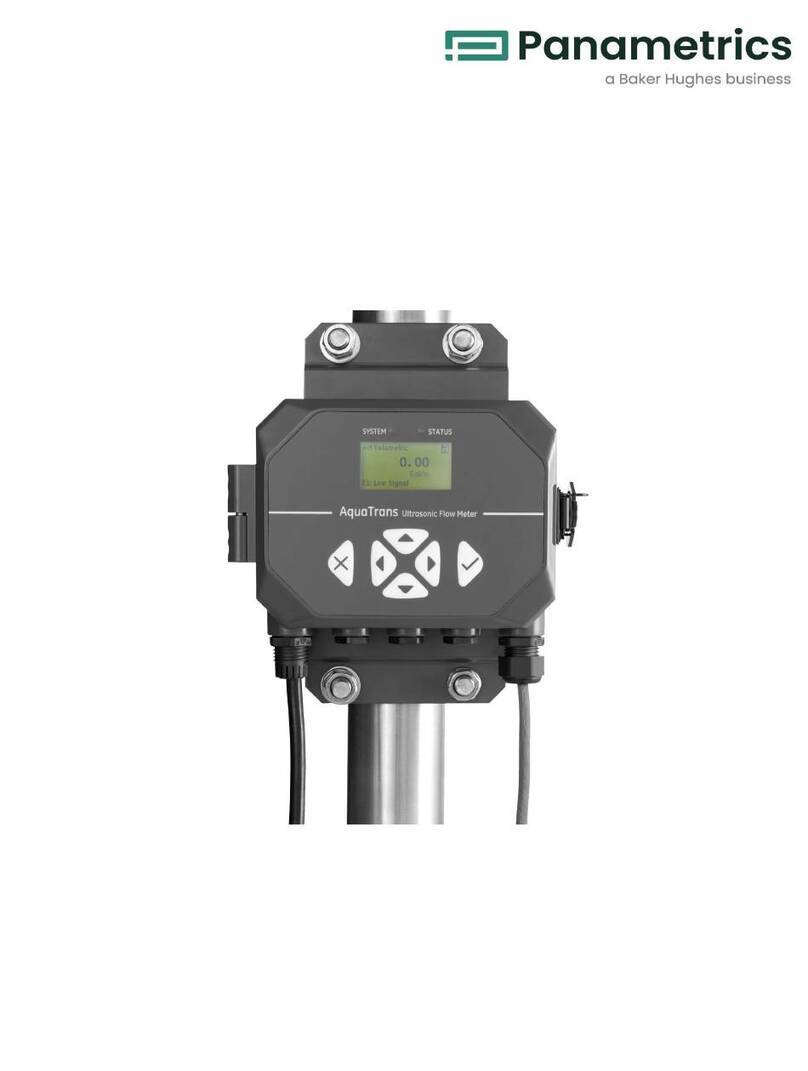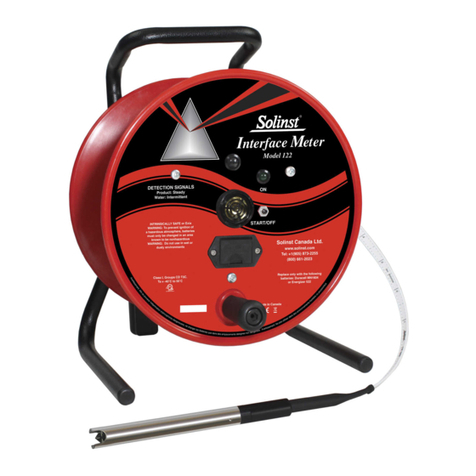Tegam 730A User manual

730A
HANDHELD BOND METER
Models:
730A
Wireless Datalogging Handheld Bond Meter
Operation
Manual
rev AA
Manual Part Number: 730A-900, Rev. AA
Published April 2022, Geneva, OH

Notices
ii
10 TEGAM WAY ● GENEVA, OHIO 44041 ● 440-466-6100 ● FAX 440-466-6110 ●
NOTICES
Copyright Notice
© TEGAM, Inc., 2022
No part of this manual may be reproduced in
any form or by any means (including electronic
storage and retrieval or translation into a
foreign language) without prior agreement and
written consent from TEGAM, Inc. as governed
by United States and international copyright
laws.
This Manual
Part Number:730A-900
Revision AA, March 2022
Supersedes: N/A
Published by:
TEGAM, Inc.
10 TEGAM Way
Geneva, OH 44041
Disclaimer and Manual Revisions:
THE MATERIAL CONTAINED IN THIS USER
MANUAL, AND ANY COMPUTER
SOFTWARE ASSOCIATED WITH THIS
USER MANUAL OR THE PRODUCTS
COVERED BY IT, ARE PROVIDED AS IS,
AND ARE SUBJECT TO CHANGE, WITHOUT
NOTICE, IN FUTURE REVISIONS.
This User Manual was current at the time of
publication. However, TEGAM is dedicated to a
process of continual product improvement, and
the products covered by this User Manual, and
any associated computer software, are subject
to periodic functional and design updates.
Please visit tegam.com for the most current
product documentation.
U.S. Government Rights
This computer software and/or technical data is
TEGAM proprietary information developed
exclusively at private expense. Computer
software and technical data rights granted to
the federal government include only those
rights customarily provided to the public,
pursuant to FAR 12.211 (Technical data) and
FAR 12.212 (Computer software) for the federal
government, and DFARS 252.227-7015
(Technical data –Commercial items) and
DFARS 227-7202-3 (Rights in commercial
computer software or commercial computer
software documentation) for the Department of
Defense. Except as explicitly permitted by the
foregoing, reproduction for non-governmental
use of the information or illustrations contained
in this computer software and technical data is
not permitted.
Compliance
FCC Notice: This equipment has been
tested and found to comply with the
limits for a Class A digital device, pursuant to
part 15 of the FCC Rules. These limits are
designed to provide reasonable protection
against harmful interference when the
equipment is operated in a commercial
environment. This equipment generates, uses,
and can radiate radio frequency energy and, if
not installed and used in accordance with the
instruction manual, may cause harmful
interference to radio communications.
Operation of this equipment in a residential
area is likely to cause harmful interference in
which case the user will be required to correct
the interference at his own expense.
Safety Notice Symbols and Terms
Safety Notices denote hazards. They indicate an
operating procedure, instruction, or practice
that, if not correctly performed or followed,
could result in damage to equipment, or injury
or death to personnel. Do not proceed beyond a
Safety Notice until all conditions and
instructions are fully understood and complied
with.
Safety Notices Symbols:
WARNING
WARNING denotes an
imminent hazard that could
result in injury to personnel or
death.
CAUTION
CAUTION denotes a hazard
that could result in damage to
the unit or other equipment.
REMINDER denotes important
information about instrument
functions, menus, and
measurements.

Table of Contents
iii
10 TEGAM WAY ● GENEVA, OHIO 44041 ● 440-466-6100 ● FAX 440-466-6110 ●
TABLE OF CONTENTS
1. Instrument Description .......................................................................................... 1-1
Specifications ................................................................................................ 1-1
Optional Accessories and Ordering Information .................................................. 1-3
TEGAM Family of Handheld Bond Meters ........................................................... 1-4
2. Preparation for Use ................................................................................................ 2-1
General Information ....................................................................................... 2-1
Feature Overview ........................................................................................... 2-1
Safety Notices and Information ........................................................................ 2-2
Unpacking and Inspection ............................................................................... 2-3
Battery Installation and Replacement................................................................ 2-4
Making Your First Resistance Measurement........................................................ 2-5
Recording Resistance Data .............................................................................. 2-6
3. Operating Instructions ........................................................................................... 3-1
Keypad Functions ........................................................................................... 3-1
LCD Display ................................................................................................... 3-2
Test Limit Menu ............................................................................................. 3-3
Auto-Power Off .............................................................................................. 3-3
Backlight and Backlight Timeout....................................................................... 3-3
Hold Function ................................................................................................ 3-3
Auto-Hold Function ......................................................................................... 3-4
Open Lead Detection ...................................................................................... 3-5
Battery Indicator ............................................................................................ 3-5
Wireless Datalogging Overview ........................................................................ 3-6
Invalid Measurement Indications ...................................................................... 3-6
4. Display Probe (Optional)......................................................................................... 4-7
Overview....................................................................................................... 4-7
Display ......................................................................................................... 4-7
Remote HOLD Button...................................................................................... 4-7
PASS/FAIL LED .............................................................................................. 4-7
UNDER/OVER Indicator ................................................................................... 4-7
Open Lead Detection ...................................................................................... 4-8
Connection .................................................................................................... 4-8
Operation ...................................................................................................... 4-8
5. Service Information ............................................................................................... 5-1
Inspection and Cleaning .................................................................................. 5-1
Calibration..................................................................................................... 5-1
Troubleshooting ............................................................................................. 5-7
Diagnostic Routines and Error Codes ................................................................ 5-8
Preparation for Calibration or Repair Service...................................................... 5-9
Expedite Repair & Calibration Form ................................................................ 5-10
Warranty..................................................................................................... 5-11
Warranty Limitations .................................................................................... 5-11
Statement of Calibration ............................................................................... 5-12
A. Required Alignment and Verification Equipment............................................................. i
B. Instrument Verification Data Sheet .............................................................................. i

Instrument Description
1-1
10 TEGAM WAY ● GENEVA, OHIO 44041 ● 440-466-6100 ● FAX 440-466-6110 ●
1. INSTRUMENT DESCRIPTION
Specifications
GENERAL SPECIFICATIONS:
Accuracy1
±(0.2% Reading + 0.02% Range) -10 to 55 °C
Resistance Ranges and Test Currents:
Full Scale
Resolution
Test Current
10.000 mΩ
1 μΩ
100 mA
100.00 mΩ
10 μΩ
10 mA
1.0000 Ω
100 μΩ
1 mA
10.000 Ω
1 mΩ
100 μA
100.00 Ω
10 mΩ
10 μA
Connector Type
M12
Max. Lead Resistance
500 mΩ per lead
Display
Four and one-half (4 1/2) digit LCD, with Range, Units,
Function, Battery, and Decimal Indicators
Display Backlight
LED Backlight with 30-second timeout
Reading Rate
3 / Second for Readings, typical
Battery Type
3 AA (IEC LR6, ANSI 15) Alkaline
Battery Life
100 hours standby, 50 hours in 10 mΩ range, typical2
Battery Indicator
Four (4) Stage Battery Charge Indicator
Keypad
Six (6) momentary switches with audible and tactile
feedback
Power Cycle
Configuration
Retention
Instrument retains:
-Range
-Test Limit
Maximum Common
Mode Voltage
30 V
Compliance
CE (2014/30/EU) / RoHS (EU 2015/863) / EU REACH (EC)
No. 1907/2006
ESD
IEC 61000-4 2:2009, Class B
EMC
EN 55022:2010+A1:2015,
Class A; EN 61000-4
3:2006+A2:2010, 10 V/m
(80 MHz to 1 GHz)
MIL-PRF-28800F, Class 2
1
95% confidence interval, approximately 2σ
2
Factors such as range, backlight, Bluetooth usage, and use of the optional display probe will affect battery life

Instrument Description
ENVIRONMENT:
Standards
MIL-PRF-28800F, Class 2
Operating Temp
-10 to 55 °C
14 to 131 °F
Humidity
5 to 95%, 10 to 30 °C
5 to 95%, 50 to 86 °F
Altitude
0 to 4600 m
0 to 15,092 ft
Vibration
Random 10 –500 Hz, 0.03 g2/Hz
Shock
30g Half Sine
Drop
4 drops from 1 m to concrete
Storage Temp
-51 to 71 °C
-60 to 160 °F
PHYSICAL CHARACTERISTICS:
Dimensions
193 x 84 x 28 mm
7.6 x 3.3 x 1.1 in
Weight (incl. batteries)
303.2 g
10.7 oz
CALIBRATION:
Recommended Interval:
1 year

Instrument Description
1-3
10 TEGAM WAY ● GENEVA, OHIO 44041 ● 440-466-6100 ● FAX 440-466-6110 ●
Optional Accessories and Ordering Information
3
PRODUCT
MODEL
DESCRIPTION
Probes
BKDP-M2
Big Kelvin Display Probe, 700 Series
BKP-M2
Big Kelvin Probe, 700 Series
BKDP-
M2S
Big Kelvin Display Probe, 700 Series, Intrinsically Safe
BKP-M2S
Big Kelvin Probe, 700 Series, Intrinsically Safe
BKEP-M2
Big Kelvin Extended Probe, 700 Series
BKP-B
Pin Kit, Spear Tip, 4 Pins per Pack
BKP-F
Pin Kit, Flat Tip, 4 Pins per Pack
BKP-H
Pin Kit, Serrated Tip, 4 Pins per Pack
BKP-J
Pin Kit, Round Tip, 4 Pins per Pack
MCDP-M2
Miniature Coaxial Display Probe, 700 Series
MCP-M2
Miniature Coaxial Probe, 700 Series
MCDP-
M2S
Miniature Coaxial Display Probe, 700 Series,
Intrinsically Safe
MCP-M2S
Miniature Coaxial Probe, 700 Series, Intrinsically Safe
MCP-A
Replacement Pins for the MCP Series Probe
MKDP-M2
Miniature Kelvin Display Probe, 700 Series
MKP-M2
Miniature Kelvin Probe, 700 Series
MKDP-
M2S
Miniature Kelvin Display Probe, 700 Series, Intrinsically
Safe
MKP-M2S
Miniature Kelvin Probe, 700 Series, Intrinsically Safe
MKP-B
Miniature Pin Kit, Spear Tip, 4 Pins per Pack
MKP-F
Miniature Flat Tip Pin Kit, 4 Per Pack
MKP-H
Miniature Serrated Tip Pin Kit, 4 Per Pack
MKP-J
Miniature Round Tip Pin Kit, 4 Per Pack
MKP-LM
Miniature Serrated Rotating Tip Pin Kit, 4 Per Pack
KC-M2
Kelvin Clip, 700 Series, Regular Length
KC-M5
Kelvin Clip, 700 Series, Long Length
KC-M2S
Kelvin Clip, 700 Series, Regular Length, Intrinsically
Safe
KC-M5S
Kelvin Clip, 700 Series, Long Length, Intrinsically Safe
3
Some accessories may not be available at time of printing

Instrument Description
Case
Accessories
700-910
Tilt Stand/Magnetic/Hanger (Factory Installed)
700-912
Tilt Stand/Magnetic/Hanger (User Installed)
700-911
Hard Carry Case
700-915
Sure Grip Cover
720-911
Spark-Proof Carrying Case
Printed Manual
730A-900
Operation Manual
Manual
Translations
Chinese, Dutch, French, German, Japanese, Korean,
and Spanish (download at tegam.com)
Service Options
710-CAL
Standard Calibration
710-17025
17025 Calibration with Report
TEGAM Family of Handheld Bond Meters
Bond Meters
710A
Handheld Bond Meter
720A
Intrinsically Safe, Handheld Bond Meter
730A
Wireless Datalogging, Handheld Bond Meter

Preparation for Use
2-1
2. PREPARATION FOR USE
General Information
The TEGAM 730A Wireless Datalogging Handheld Bond Meters are high-accuracy micro-
ohmmeters that provide accurate resistance readings in a wide range of manufacturing and
service applications. These full-featured, durable, and versatile instruments simplify the
process of resistance measurement through the intuitive user-interface.
Feature Overview
•Two-way communication and control with Android, iOS, or Windows software
•Bluetooth®low energy wireless technology
•Internal storage of 20 measurements
•Battery life of 100 hours in standby, 50 hours in 10 mΩ range
4
•Four and one-half (4½) digit LCD with LED Backlight
•Easy to clean
•Automatic and manual HOLD modes
•Programmable test limits with OK and FAIL annunciators
•OVER and UNDER annunciators
•Open lead and DUT (Device Under Test) detection
•Clear/Undo last saved measurement
•Durable: Meets MIL-PRF-28800F, Class 2 requirements
•Optional Tilt Stand/Magnet/Hanger
4
Factors such as Bluetooth usage, range, backlight, and use of the optional display probe will affect battery life

Preparation for Use
2-2
Safety Notices and Information
Read this Operation Manual thoroughly before using the instrument to become familiar with its
operations and capabilities.
Visually inspect instrument before using. Do not use if unit appears damaged or with any part of the
case removed.
WARNING
MAINTENANCE INSTRUCTIONS WITHIN THIS MANUAL ARE FOR USE BY QUALIFIED SERVICE
PERSONNEL ONLY. DO NOT ATTEMPT TO SERVICE THIS UNIT UNLESS YOU ARE QUALIFIED TO DO
SO.
SHOCK HAZARD
Disconnect probes from DUT and turn the unit off before removing the battery cover.
Always disconnect probes from DUT before opening the instrument housing. Internal circuits
can present a shock hazard if leads are connected to a source of elevated potential.
Do not use this instrument if the housing, probe wiring, probe, or probe handles are damaged
or distorted. Housings and wire insulation are part of the personnel protection system, and if damaged
could expose users to elevated potentials.
EXPLOSION HAZARD
Never use or store this product with batteries installed, or change batteries, in an
environment where explosive or flammable vapors or dust suspensions may exist.
Do not attempt to recharge alkaline batteries.
Do not put batteries into bags designed to protect parts from electrostatic discharge (ESD).
These bags are specially designed with metal shielding which can short circuit a battery.
Do not expose batteries to extreme heat or fire. Observe all regional laws and regulations when
disposing batteries.
BURN HAZARD
Do not touch a probe that has been exposed to toxic substances or extremely high or low
temperatures.
Safety Notices and Information continued on next page . . .

Preparation for Use
CAUTION
RISK OF INCORRECT READING
Do not use when AC or DC voltages exist. Excessive voltage could result in an incorrect reading, or
in more extreme cases, a blown fuse that will result in incorrect readings and need for repair.
Do not use on reactive loads exceeding 2mH or 100uF. Measurements may also be impacted when
a large inductive load is measured in the presence of high 50/60 Hz power. Polarized capacitors should
be avoided.
RISK OF INSTRUMENT DAMAGE
Only replace batteries with size AA (IEC LR6, ANSI 15). Observe proper polarity when installing
batteries. Do not mix old and new batteries.
Do not apply voltages across leads. Excessive input voltage could result in blown fuse, component
damage, or fire. Application of excessive voltage is not covered by the warranty.
Avoid making sharp bends in probe or sensor lead wires. Bending lead wires at sharp angles can
damage the wire and cause probe failure.
Static discharge through a connected probe may cause instrument damage. Use care to avoid
static discharge when handling the instrument or connected probes.
Unpacking and Inspection
Each instrument is electrically and mechanically inspected before shipment. Upon receiving
your new TEGAM Handheld Bond Meter, unpack all items from the shipping container and
check for any obvious damage that may have occurred during transit. Use the original
packing materials if reshipment is necessary.
If any dents, broken, or loose parts are seen, do not use the equipment. Notify TEGAM
immediately.
Check that all items are present. If any items are missing, notify TEGAM immediately.
The following items are included with every new instrument:
1. One (1) Handheld Bond Meter;
2. One (1) Quick Start Guide;
3. Statement of Traceability;
4. Three (3) AA, 1.5 V batteries; and
5. Optional accessories (if purchased).

Preparation for Use
2-4
Battery Installation and Replacement
Three (3) AA 1.5 V batteries are supplied with the instrument, but not installed. Read the
following battery replacement instructions before attempting to install or remove the
batteries.
CAUTION
Always turn the instrument off and disconnect any connections to DUT before
replacing the batteries. Re-install the battery compartment cover before resuming
use of the instrument.
CAUTION
The battery compartment is sealed with a rubber gasket. Use care to not damage
the gasket when removing or installing the battery compartment cover.
CAUTION
Remove the batteries when storing the instrument for an extended period of time or
in a high temperature environment to prevent battery leakage and possible damage
to the instrument.
CAUTION
All user and calibration parameters may be corrupted if batteries are removed while
power cycling the instrument or setting a parameter. Always turn the instrument
off and allow the instrument to fully turn off before changing the batteries.
To install or replace batteries:
Required Tools: Phillips Head Screwdriver
1. Identify the battery compartment located
on the back of the instrument (see Error!
Reference source not found.);
2. Remove the two (2) battery compartment
retaining screws;
3. Remove the battery compartment cover;
4. If present, carefully remove old batteries
being careful to not damage the battery
contacts;
5. Observing proper polarity, install three (3)
new, AA alkaline (IEC LR6, ANSI 15) batteries;
6. Re-install the battery cover and two (2)
retaining screws;
7. At initial power on after battery
replacement, allow approximately 30 seconds
for instrument to stabilize.
Figure 1: Battery Installation
Battery
Compartment
Retaining
Screws
Gasket

Preparation for Use
2-5
Making Your First Resistance Measurement
TEGAM’s 700 Series Handheld Bond Meters are designed for easy operation, while still
providing a feature-rich experience via the intuitive user interface.
To get started making resistance measurements right away, follow these steps:
1. Perform Section 2.5, Battery Installation and Replacement;
2. Connect probes to unit. Be sure to check the orientation of the connector as it is
installed. Once the connector is lined up with the plug, push the plug into the
connector and twist the outer ring of the connector clockwise.
3. Press to turn unit on;
4. The unit will light all segments of the display as it performs a power on self-test;
5. The instrument will display a resistance if connected to a device or “-----”if not
connected. If kelvin clips are connected and closed, “nodut” will be displayed;
6. Press to change ranges or to put unit in Auto-Range mode.
We know you are eager to begin using your new bond meter, but this overview is just the
beginning. Please take a moment to familiarize yourself with this Operation Manual to learn
about all the features and benefits of your new TEGAM Handheld Bond Meter.

Preparation for Use
2-6
Recording Resistance Data
The TEGAMLink B mobile application provides convenient two-way communication between
your TEGAM Bond Meter and compatible Bluetooth low energy technology / version 4.0
mobile devices. TEGAMLink B duplicates the Bond meter display for easy monitoring from up
to 30 feet away. See Figure 2 below for a description of the TEGAMLink B user interface
Enter settings, (On IOS this can be found
in the IOS settings menu)
Connect to device within range
LIMIT
Set Maximum Pass Resistance
RANGE
Change instrument selected range
STORE
Store current reading
HOLD
Put instrument in HOLD mode
CLEAR
Clear all stored readings
View stored data
View current reading while in store data screen
Figure 2: TegamLink B User Interface Description
To connect to the TEGAMLink B mobile app:
1. Before beginning, ensure your mobile device is Bluetooth low energy technology /
version 4.0 compatible;
2. Visit the Google Play™ store or Apple App store and search for “TEGAM” to download
TEGAMLink B;
3. Install the mobile app to your device and accept the license agreement and permissions
requests;
4. Open TEGAMLink B

Preparation for Use
2-7
5. Verify that Bluetooth wireless communication is active on your mobile device;
6. On your Bond Meter, press to turn Bluetooth wireless communication on;
The display Bluetooth icon is flashing, indicating the instrument is in pairing mode.
7. In TEGAMLink B, touch ;
8. In the displayed list of available instruments, touch the entry that corresponds to your
Bond Meter’s serial number (located on back of instrument);
The display Bluetooth icon is steadily illuminated and the serial number will show in
the app, indicating the instrument is paired to the mobile device.
If your device is not able to connect check that the application’s location permissions
have been allowed.
Congratulations! You’re now ready to make accurate and reliable resistance measurements,
wherever and whenever you may need to. We know you are eager to begin using your new
bond meter, but this overview is just the beginning. Please take a moment to famil iarize
yourself with this Operation Manual to learn about all the features and benefits of your new
TEGAM bond meter.

Operating Instructions
3-1
3. OPERATING INSTRUCTIONS
Keypad Functions
The instrument keypad is a six (6) key, sealed membrane keypad. Each key provides audible
and tactile user feedback when pressed. Key functions are described in Figure 3-1 below.
Power instrument ON or OFF
(1.5s)
Disable auto-power OFF while
instrument is on.
(1.5s)
Enter Test Limit Menu (See Section
3.3)
While in Test Limit Menu, save current
value and advance to next parameter
Toggle display backlight
(1.5s)
Disable backlight 30-second timeout
Hold currently displayed measurement
and OK/FAIL result
(1.5s)
Enter/Exit Auto Hold mode (See
Section 3.7)
Increment/Decrement through ranges, including AUTO
While in Test Limit Menu, advance or reverse selected parameter
Send/save measurement
Undo/clear last sent/saved measurement
(1.5s)
Clear all data stored in memory
Turn wireless communication ON/OFF
Figure 3-1: Keypad Button Functional Description
The , , , and keys have multiple functions which can be accessed by
momentarily pressing the key, or alternatively, by pressing and holding the key for
approximately 1.5 seconds. Throughout this Operation Manual, the press and hold sequence
is indicated by the key designator followed by the subscript (1.5s). For instance, (1.5s)
indicates that the key should be pressed and held for 1.5 seconds, then released to
access the desired function.

Operating Instructions
3-2
LCD Display
The display is a large, easy to read, LCD display, with an LED backlight for clear viewing in
low-light conditions. It can simultaneously display the resistance reading, range, PASS/FAIL
status, open lead detection, over/under indication and the battery level.
See Figure 3-2 below for further description of each display indicator.
1
Measurement is overrange
2
Measurement is 10% or less
of range
3
Solid: Hold function is active
Flashing: Auto Hold function
is active
4
One or both probes are not
electrically connected (See
Section 3.8, Millli-Ohm Mode
Milli-Ohm mode is an
quality of life tool for
users who like to take
all their measurements
in mΩ. Press (1.5s)
to access the Test
Limit Menu then
continue then press
eight times or until the
unit shows dISPL.
Press the keys to
switch between
standard mode (Ω)
and milli-ohm mode
(mΩ).
Open Lead Detection)

Operating Instructions
5
If a probe is not electrically
connected, the open channel
is indicated (See Section 3.8,
Millli-Ohm Mode
Milli-Ohm mode is an
quality of life tool for
users who like to take
all their measurements
in mΩ. Press (1.5s)
to access the Test
Limit Menu then
continue then press
eight times or until the
unit shows dISPL.
Press the keys to
switch between
standard mode (Ω)
and milli-ohm mode
(mΩ).
Open Lead Detection)
6
Remaining battery life
7
Resistance measurement
8
AUTO range is active
9
Currently selected range
10
The measurement is less than the test limit
11
The measurement is greater than the test limit
12
Reserved for future use
13
Flashing: Bluetooth is searching for connection
Solid: Bluetooth is connected
Flashing rapidly: communication issue, restart device.
Figure 3-2: LCD Display Description

Operating Instructions
3-4
Test Limit Menu
Key designators followed by (1.5s), e.g. (1.5s), indicate that the key should be
pressed and held for 1.5 seconds, then released to access the desired function.
Test limits are available for the user to easily identify if a measurement is above or below a
resistance value with an OK/FAIL indication. Press (1.5s) to access the Test Limit Menu.
From within the Test Limit Menu, press to step through the digits, decimal point, and
resistance range. Press the keys to advance or reverse the selected value for the
active parameter. The active parameter value will flash on the display.
To enter the Test Limit Menu, press (1.5s).The active parameter value will flash on the
display.
Press to save a setting and step to the next parameter. If no key is pressed for 10
seconds, the current configuration is saved and the instrument will exit the Test Limit Menu.
Auto-Power Off
Key designators followed by (1.5s), e.g. (1.5s), indicate that the key should be
pressed and held for 1.5 seconds, then released to access the desired function.
To conserve battery life, the instrument automatically turns off if no key is pressed for 20
minutes. To disable this feature, press (1.5s). The remaining battery life indicator will
flash once, indicating auto-power off is disabled.
Auto-power off will remain disabled until instrument power is cycled. At next power on,
auto-power off returns to the default enabled condition.
Backlight and Backlight Timeout
The instrument includes an LED backlight feature to ensure measurement data can be easily
read in low-light conditions. To activate the backlight, press .
Once the backlight is activated, it will automatically turn off to preserve battery life if no key
is pressed within 30 seconds. To disable the backlight timeout feature, press (1.5s). The
backlight will flash to indicate the timeout feature has been disabled. To re-enable the
backlight timeout feature, turn the backlight off then on by pressing twice.
Hold Function
Press to hold the current reading. HOLD is displayed at the top-center of the LCD
display. New measurements are not displayed while the hold function is active. If test limits
are active, the OK or FAIL annunciators will also be held. To disable the hold function and
resume normal operation, press again.

Operating Instructions
3-5
Auto-Hold Function
The Auto Hold function allows the user to take a measurement, have the unit determine a
stable reading, and hold that value. Once the user is ready to make the next measurement,
is pressed momentarily to clear the last reading from the display and re -initiate Auto-
Hold mode.
To use the Auto-Hold Function:
1. Press (1.5s) to initiate Auto-Hold mode.
The unit will not initiate Auto-Hold mode if it is already in Hold mode. If the HOLD
indicator is solid, simply press to exit Hold mode and try initiating Auto-Hold
mode again.
2. The HOLD indicator will begin to flash.
3. If the unit is not connected to a Device Under Test (DUT):
a. “-----” will appear on the display.
b. Connect leads to DUT.
4. When the unit detects a connection, the display of the unit will go blank, then
begin to cycle. The cycling animation on the display indicates that the unit is
taking measurements of the DUT.
5. Once a stable value has been determined and the measurement is completed, the
unit will display the reading of the DUT along with PASS/FAIL status (if enabled).
6. The determined reading and status are temporarily saved and will stay displayed
unless is pressed or the unit is power-cycled.
7. Press to re-activate Auto-Hold mode.
8. The HOLD indicator will begin to flash.
9. If the unit has been disconnected from the DUT, “-----” will appear on the display.
10. The unit is ready to take another measurement.
To exit Auto-Hold mode, press (1.5s). The HOLD annunciator will turn off. The unit
is now in normal operating mode.
For best results, put unit in Auto-Range when using Auto-Hold.

Operating Instructions
3-6
Millli-Ohm Mode
Milli-Ohm mode is an quality of life tool for users who like to take all their measurements in
mΩ. Press (1.5s) to access the Test Limit Menu then continue then press eight times
or until the unit shows dISPL. Press the keys to switch between standard mode (Ω)
and milli-ohm mode (mΩ).
Open Lead Detection
The 700 Series Handheld Bond Meters feature open lead detection for all ranges. This
feature monitors the test current across the leads on each channel. A small current is
sourced between the Kelvin connection of each channel’s test leads. This detection is
independent of whether a DUT is or is not connected.
If the unit detects an open circuit in either channel it will illuminate the OPEN annunciator
along with the channel(s) the unit has detected an open circuit in.
When using the unit with MKP, BKP, and MCP probes, the OPEN and channel
annunciators will be illuminated when not connected to a DUT.
Battery Indicator
The battery voltage indicator provides a visual representation of approximate remaining
battery life. It is located at the top-right of the
display.
The battery voltage indicator uses three bars
to represent remaining battery life. Figure 4
shows the approximate battery life for each
bar.
At zero (0) bars, the instrument will
momentarily display Lo bATT and initiate a
shutdown sequence. To prevent disruption of
the measurement process, the batteries
should be replaced before the battery voltage
indicator reaches zero (0) bars. See Section 2.5, Battery Installation and Replacement.
BARS
APPROX.BATTERY LIFE
3
100% - 50%
2
50% - 20%
1
20% - 5%
0
0% - Shutdown Initiated
Figure 4: Battery Voltage Indicator
Table of contents
Other Tegam Measuring Instrument manuals
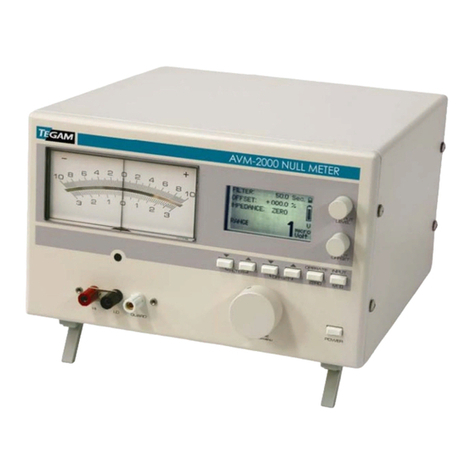
Tegam
Tegam AVM-2000 Troubleshooting guide
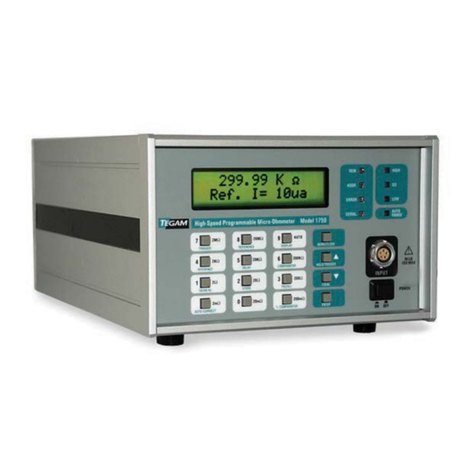
Tegam
Tegam 1750 User manual
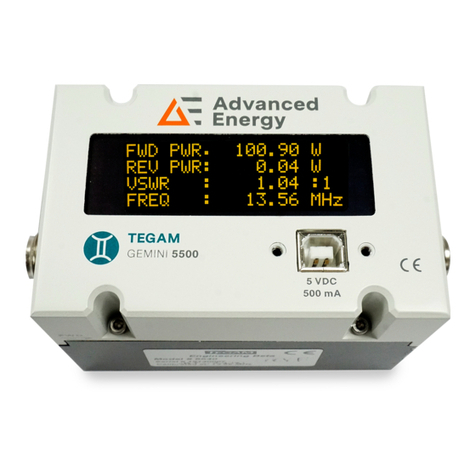
Tegam
Tegam Advanced Energy GEMINI 5540A User manual
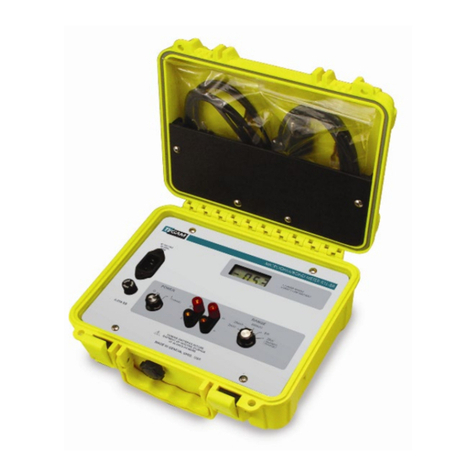
Tegam
Tegam R1L-BI User manual
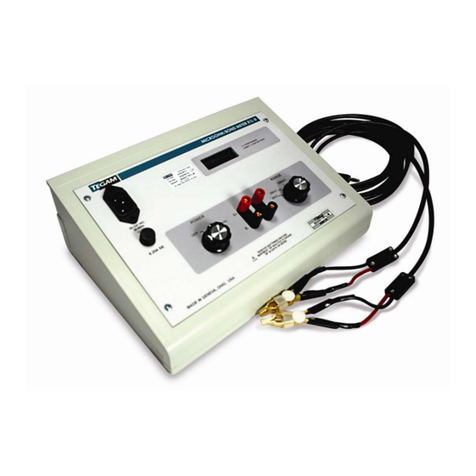
Tegam
Tegam R1L-B User manual
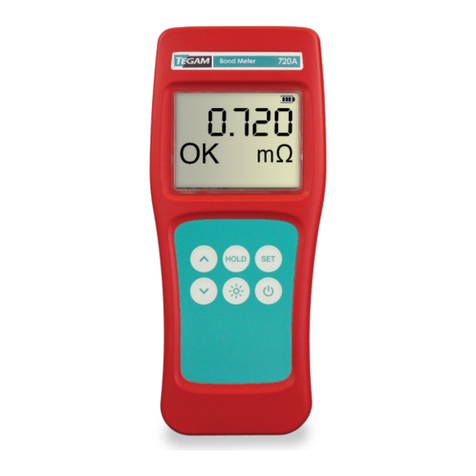
Tegam
Tegam 720A User manual
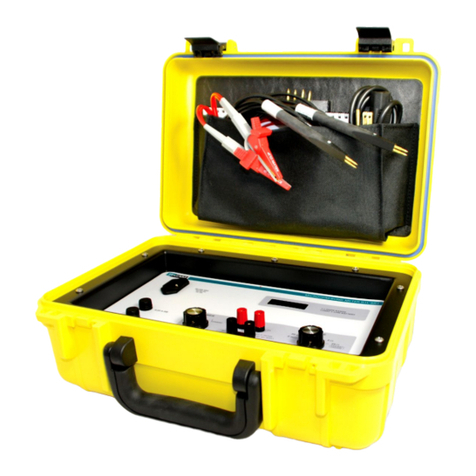
Tegam
Tegam R1L-BIR1 User manual
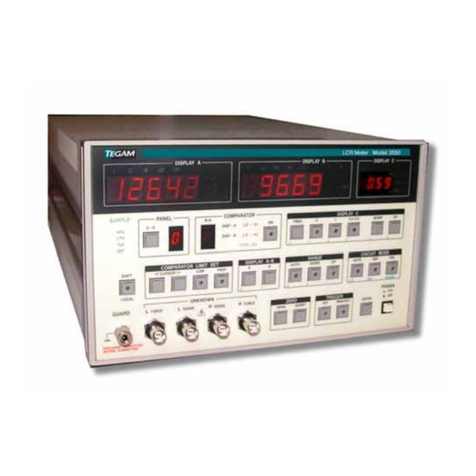
Tegam
Tegam 3550 User manual
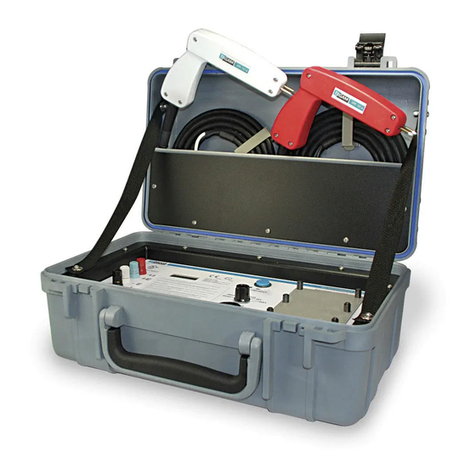
Tegam
Tegam R1L-E2A User manual
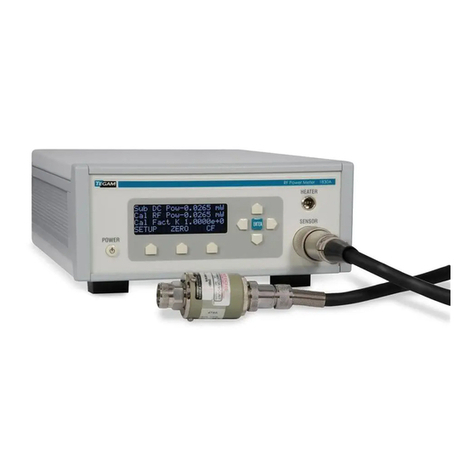
Tegam
Tegam 1830A Troubleshooting guide
